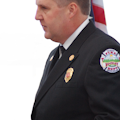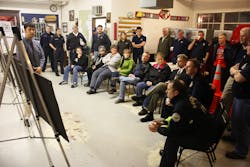Building community support for a new fire station project can sometimes be the most challenging part of the entire project. Time and time again, in all regions of the country, we have seen voters reject bond measure after bond measure to fund the construction of a new fire station that is badly needed in their community.
While we know many people will generally oppose any new tax, there may be a number of other reasons that voters are quick to reject these bond measures. And we can’t always place the responsibility on the voters unless we can say that we did everything we could to educate the community about our needs well in advance.
Explain the need
Building community support for a new fire station begins long before the question to fund such a project appears on the voter’s ballot. If you wait to embark on a community support campaign to align with an election, you’ve likely waited too long and shouldn’t be surprised if the measure meets resistance and is ultimately rejected at the polls. Many voters perceive an election campaign to be nothing more than a sales campaign and will generally be quick to make the decision “not to buy,” especially when they don’t understand the need.
Helping the community (voters) to understand the need is one of the essential elements of a successful bond measure. A well-known quote by author William Bridges really helps put it in perspective, “People aren’t in the market for solutions to problems they do not see, acknowledge and understand.”
For us in the fire service, it is easy to understand the need for a new fire station facility. Within a minute we can quickly identify, point out and usually quantify in some terms a number of deficiencies in an aging and inadequate fire station facility that we know needs to be replaced. But the majority of our community members, without any fire service experience, have no understanding of what a fire station is supposed to be and needs to be.
Put yourself in their position: Pick a service industry business located in your community that you know nothing about and then ask yourself, “Is the building in which the business is located adequate for their needs? Does it have adequate space for their business to be successful today and in the future? Does the building have the amenities and mechanical features to make it both safe and efficient? What does the building lack that the business needs?” Because you know nothing about the building needs of the business, you can’t answer any of these questions; you can only think of more questions to ask. And now you know how most voters feel when being asked to fund a fire station. They often don’t understand why it’s needed.
Long before the time comes to ask voters to fund a new fire station, we need to educate them about what a fire station really is. The fire station isn’t just a garage to park the fire engines in, with a kitchen where the firefighters eat, play cards and tell stories. We know this, but do our community members know this? Are we inviting the community into our fire stations where we have the best opportunity to educate them about what a fire station building is?
My personal experience for a number of years was a reluctance to invite the public into our fire station. The station was small with very cramped quarters, it was in need of a number of visible repairs, there wasn’t a part of the building that didn’t look worn and uncared for, even though the care and maintenance of the building had become quite labor-intensive because of its age and use. Inviting the public into the station seemed to be an embarrassment and contrary to the professional image that our organization continually strives to display. But by keeping the public out, protecting them from seeing the conditions, we were missing a great opportunity to educate them.
Begin by inviting the public into your fire station—and this means you have to let them past the lobby or public area. Take the time to point out and explain the deficiencies in the building and how the building impacts your ability to provide service. Tell them the purposes and functions the fire station building serves. Within the short station tour, do what you can to educate them about the conditions and what it is like to work in a fire station, specifically your fire station. Make arrangements with neighboring jurisdictions to bring groups from your community to tour their fire stations, especially when you have the opportunity to show your constituents what a “real” fire station is. Even people with no fire service knowledge or experience can be educated quickly about the need when given the visual opportunity to compare and contrast an inadequate fire station with one that is meeting the needs of the community. Take advantage of one of the things we do well in the fire service—educating and training others.
You know the need exists for a new fire station, but you need the community members to know the need exists and, unfortunately, they may not believe you on your word alone. Well before a bond measure makes it to the ballot, invite a broad cross-representation of key stakeholders to become involved in the Needs Assessment process. Include representatives from the business community, social and civic organizations in the community, faith-based groups, special interest groups, and don’t leave out those who can represent the interests of the “citizens at-large.” Whether you decide to bring this collaboration of individuals together as a formal or informal group, these individuals will likely take a great deal of ownership in the overall process if you allow them. Don’t let them freelance. Like any group, they need a leader to be effective, and the leader should be someone who has the authority to represent the interests of your fire service organization in the process.
Your fire department and the leaders of your organization probably know 3–5 years in advance of when the community is going to be asked to support the construction of a new fire station. This is when the focused process of building community support needs to begin. And remember that community support is about giving the community knowledge and understanding of the need. Using this time effectively to build progressive community support will lead to positive support of funding to build a new fire station. While you should recognize that there will always be naysayers, know that a much larger majority of the community will get behind and support a cause they understand.
Don’t “campaign”
It’s important to understand there is a difference between building community support and an organized election campaign. In most cases, a fire department that operates as a function of government is not allowed by law to “campaign” for or against a measure; rather, it can only offer factual statements for the purpose of informing the voters of the details of the measure they are being asked to consider. This can be challenging since during an election (which is usually considered to be once a measure has been filed with the election office), a department or anyone representing the department cannot request voters to “Vote Yes” or make statements recommending they “Vote Yes”; either could be a violation under state and/or local governances or laws. Take advantage of all of the time you have available to you before it’s time to campaign and build your support network. In my experience, the community supporters developed early on were the ones who self-initiated as an organized political action committee (PAC) and ran the campaign in support of the bond measure to fund the construction of a new fire station.
In sum
Building a new fire station is not easy, but it is a very exciting and rewarding experience. The tasks leading up to building a new fire station are even more challenging, but should be equally as rewarding in the end. Starting very early to build the community knowledge and understanding of the need is where your support will come from. With an army of supporters who believe in the need, the steps toward a successful bond measure to fund the construction of a new fire station are much easier. There is nothing better than having community members telling other community members how badly a new fire station is needed before they hear it from you.
About the Author

Alan Predmore
Chief Alan Predmore has been in the fire and EMS field for 32-plus years. Chief Predmore attended the fire sciences program at Bellevue College and graduated from the fire science program at Columbia Southern University. Chief Predmore has served as fire chief for the City of Buckley, WA, Fire Department for the past 17 years and serves as an incident commander on the Pierce County Type III All-Hazards Incident Management Team.
